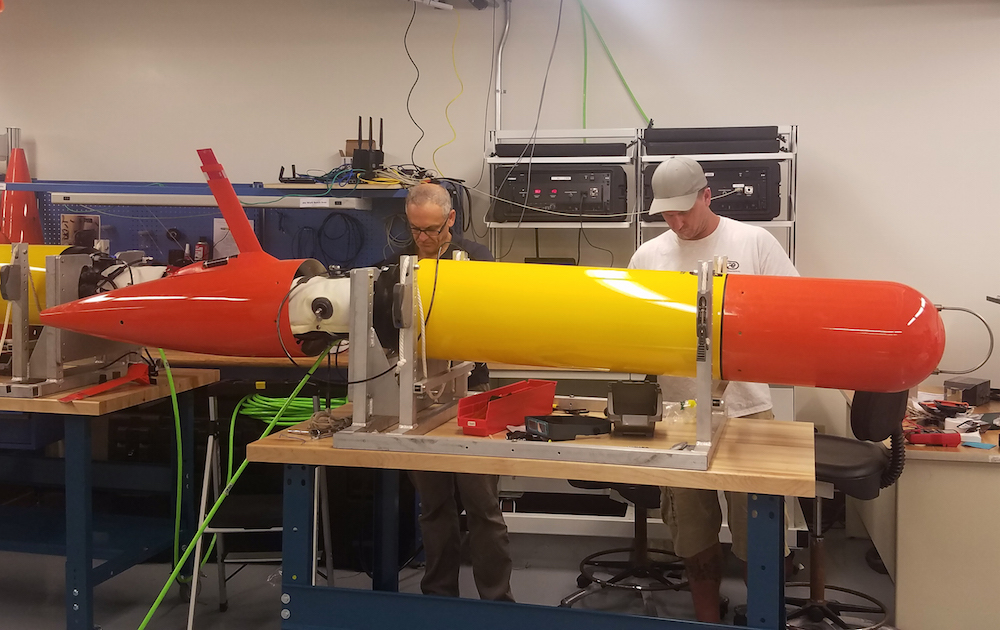Self-driving robots collect water samples to create snapshots of ocean microbes
 Brett Hobson from MBARI and Gabe Foreman from the University of Hawaii prepare a long-range AUV for field trials. Image: Chris Preston © 2018 MBARI
Brett Hobson from MBARI and Gabe Foreman from the University of Hawaii prepare a long-range AUV for field trials. Image: Chris Preston © 2018 MBARI
For the first time, scientists from the University of Hawai‘i at Mānoa (UH Mānoa) and the Monterey Bay Aquarium Research Institute (MBARI) will deploy a small fleet of long-range autonomous underwater vehicles (LRAUVs) that have the ability to collect and archive seawater samples automatically. These new robots will allow researchers to track and study ocean microbes in unprecedented detail.
Ocean microbes produce at least fifty percent of the oxygen in our atmosphere while removing large amounts of carbon dioxide. They also form the foundation of marine food webs, including those that support global ocean fisheries. Edward DeLong and David Karl, oceanography professors in the UH Mānoa School of Ocean and Earth Science and Technology (SOEST) have been studying these microbes for decades. For this project, they and their teams are collaborating with engineers from MBARI to test new ways of adaptively sampling oceanographic features such as open-ocean eddies, swirling masses of water that move slowly across the Pacific Ocean, which can have large effects on ocean microbes.
In late February 2018, MBARI engineers completed the construction and testing of three new LRAUVs in collaboration with UH Mānoa scientists, and delivered them last week for their first deployment in Hawaiian waters. As the LRAUVs move through the ocean, they collect information about water temperature, chemistry, and chlorophyll (an indicator of microscopic algae) and send these data to scientists on shore or on a nearby ship. Additionally, a unique aspect of these AUVs is an integrated Environmental Sample Processor (ESP), a miniature robotic laboratory that collects and preserves seawater samples at sea, allowing researchers to capture a snapshot of the organisms’ genetic material and proteins.
“The new LRAUVs can transit for over 600 miles, and use their own “eyes and ears” to detect important oceanographic events like phytoplankton blooms,” DeLong explained. “These new underwater drones will greatly extend our reach to study remote areas, and also will allow us to sample and study oceanographic events and features we can see by remote satellite imaging, even when ships are not available.”
An expeditionary cruise aboard Schmidt Ocean Institute’s (SOI) research vessel Falkor leaves on March 10 for open-ocean sea trials of MBARI’s newly-outfitted LRAUVs. During this cruise, the researchers will locate an eddy using satellite data and then deploy the LRAUVs to survey the feature and collect water samples.
When the robots return to the surface and are recovered, UH Mānoa researchers will extract DNA from the filters. This information will provide unique insight into the eddy’s duration, stability and influence on the ocean systems; and will improve current ocean models, which are critical for developing expectations on the health of future oceans.
Read more at News Deeply, Futurism, Hawaii Public Radio, New Atlas, UH News and Science Daily.
UPDATE 03-28-18: Read about it and watch the video report in Smithsonian Magazine.
UPDATE 04-10-18: Read about the conclusion of the month long research cruise on Hawaii News Now.
UPDATE 04-19-18: Read more about the collaboration in MBARI’s Annual Report.




